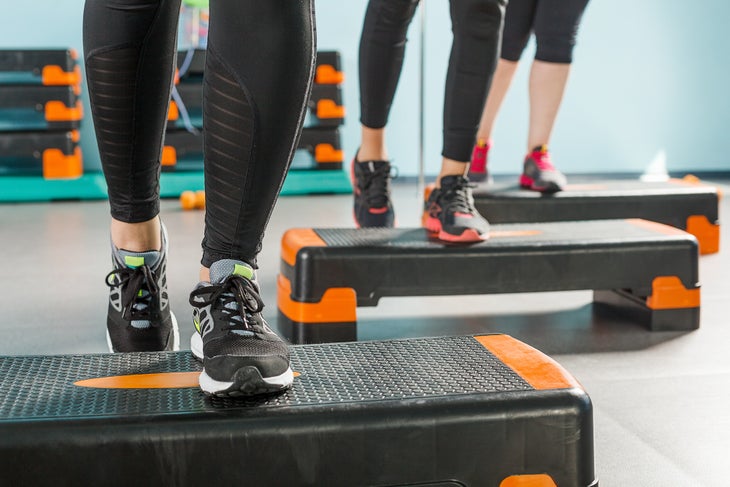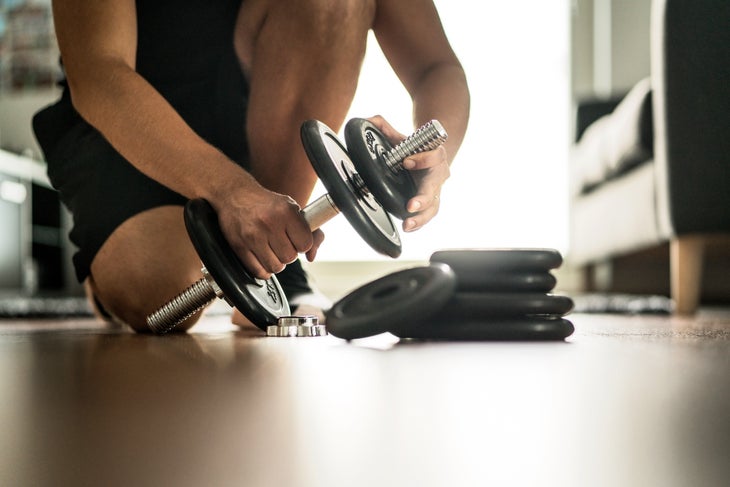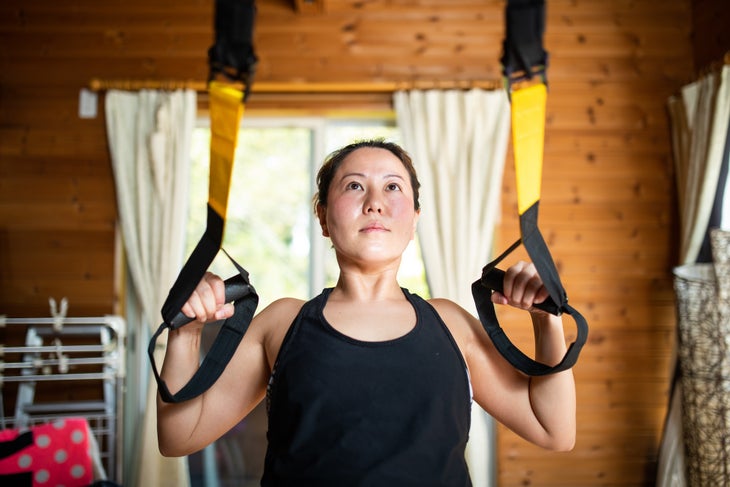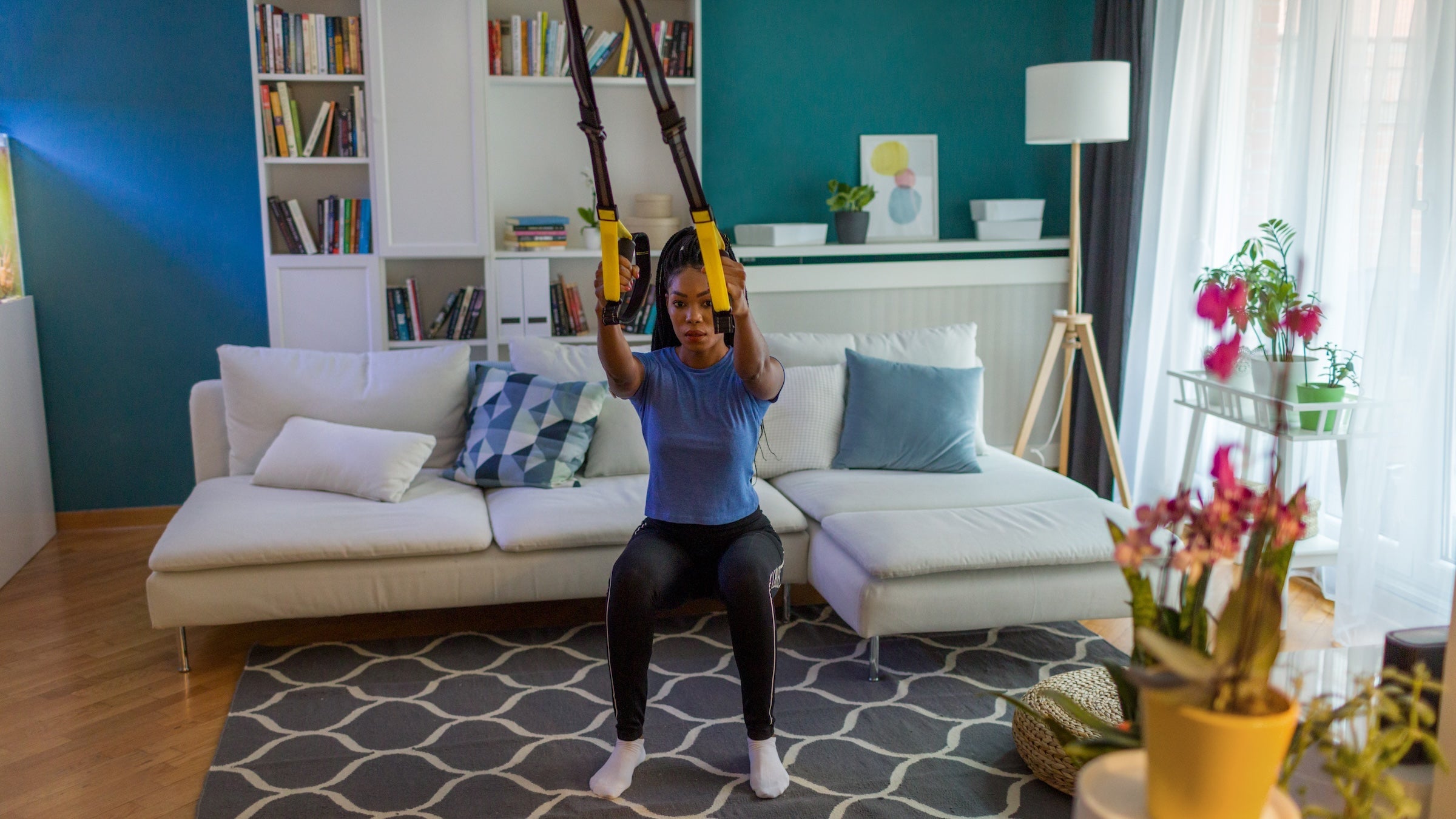Now, as the leaves fall and winter looms, is a great time dial in your home gym. Spend your addressing any aches, pains, or muscle imbalances, so you can hit the trails stronger this spring. Working out at home offers loads of flexibility, and it doesn’t have to break the bank. Here are three exercises and three home gym equipment additions I’d add into a workout routine.

Adjustable step
The adjustable step is a highly versatile piece of gym equipment for hikers. Adjustable steps are usually between 3 to 4 inches on the lowest height and each additional riser adds 2 to 4 inches depending on the model. With the lower height, you can focus on form and movement control. As you get stronger, add risers to increase the range of motion and difficulty level. This will maximize your workout efforts and help reduce risk of injury on lots of different types of terrains and on-trail obstacles. One of my favorite exercises for hikers is the lateral step-down.
Lateral Step-downs
The lateral step-down will do wonders for your knee health by strengthening the hip and quad muscles. In addition, this movement can help reduce downhill hiking knee pain.
For hikers, start this exercise with three sets of 10 to 15 repetitions at the lowest step height. If you can maintain good form and control—meaning your knee stays in line with your second toe and doesn’t move inward—then you are ready to increase the step height. Add a riser, repeat sets and reps until proficient, then progress to add another riser. If you experience any knee pain during this exercise, try a lower step height.
- Start by standing with your left foot on a step. Bending your left knee, slowly lower the right foot toward the floor and tap your heel. Try not to reach for the floor with your right foot; instead, lower yourself only with the left leg.
- Press through the left foot to return to the start position. Slow and controlled is the key here; fast reps won’t do you any good. Aim for a three-second lower. Do 10 to 15 repetitions, then switch legs.
Try to keep your hips level during this exercise. Imagine two flashlights on the front of your hips, one on each side. As you raise and lower, you want the flashlights to shine straight forward during the exercise. By keeping your hips level, you will engage your side hip muscles, which are essential for healthy knees.

Adjustable Weights
Arguably one of the most versatile additions to any home gym would be a set of adjustable dumbbells. There are numerous brands available that allow for weight ranges from 5 to 90 pounds, and they don’t take up as much space as non-adjustable dumbbells.
There are no shortages for exercise options using dumbbells. There are lots of variations of squats, deadlifts, carries, presses, rows, and lunges to help you get stronger for both hiking and life demands.
Goblet Squats
Goblet squats are friendly for beginners and advanced gym-goers alike, and they offer many benefits for all skill levels, especially strengthening muscles in the torso, improving posture.
The goblet squat offers a slight variation on the traditional squat. Keeping your feet about shoulder width apart, grab a weight and hold it close to your chest as you perform a squat. Use a weight that allows you to complete the reps with good control. As you squat, keep your core engaged as you unlock your knees, bringing your rear toward the floor.
Maintaining an upright torso and engaged core, squeeze your glutes to return to standing. Avoid letting the knees move inward during the squat throughout the movement. By keeping the weight close to your chest, you engage more muscles in the mid-back and core, which will help you carry a loaded backpack on the trail.
Begin with three sets of 15. If you can complete the reps with ease, increase the weight until you find the last two to three reps more challenging.

Suspension Trainer
A suspension trainer or similar brand is another valuable piece of home gym equipment. There are so many benefits to suspension trainers: They’re portable, making them great for travel, and they’re quite versatile. Suspension trainers generally come with a door attachment that allows you to anchor the trainer in any room of the house.
With the suspension trainer in place, you can perform a variety of squats, lunges, rows, and presses. There are also a number of great core exercises you can add in such as fall-outs and plank variations. One of my favorite exercises for hikers are reverse lunges. Suspension trainer lunges are the same as a standard reverse lunge but your arms can now take some of the load as you descend and rise. With help from the arms, you’re putting less . Using the suspension trainer to modify the reverse lunge, hikers with ache-prone knees can build strength without adding too much pressure to the joint.
Reverse Lunge
, hold the suspension trainer straps so they are taut in front of you, keep your core tight and take a big step backward, lowering your hips to bring your back knee toward the floor. Keep your back knee directly below the hip in the bottom position of the lunge. Make sure your front knee stays stacked over your ankle during the lunge—it shouldn’t push forward.
Return to standing by squeezing the glute on your front leg while pressing through the front foot. Avoid leaning forward as you do so; keep your torso upright, your core engaged, and the suspension trainer straps taut the whole time.
Perform a set of 10 on each leg before switching to the other leg. Repeat three times.


